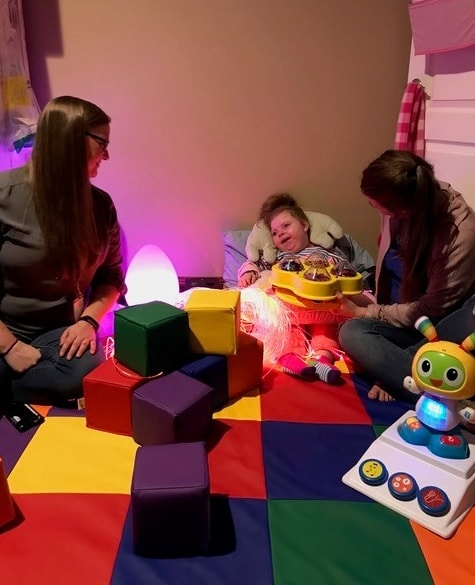As a wish manager for Make-A-Wish® South Carolina, Katlyn Gould is a lot like a fairy godmother. She, her colleagues, and Make-A-Wish volunteers spend their days granting wishes for critically ill children ages 2 1/2 to 18.
Founded in 1984, Make-A-Wish® South Carolina granted 184 wishes in FY 2017, and the nonprofit is on track to grant 200 wishes in FY 2018. In the past six years, the nonprofit organization has granted 950 wishes to children across the state. Make-A-Wish® South Carolina is entirely donor-funded and .79 cents of each dollar donated goes directly toward wish-granting.
While many “wish kids” — 31 percent — wish for trips to Disney parks or cruises and others (13 percent) wish to meet celebrities and professional sports players, Make-A-Wish South Carolina® also grants wishes for in-home sensory rooms. Recently, the nonprofit began consulting with Enabling Devices for advice on outfitting sensory rooms for some of their wish kids.
Sensory rooms are spaces where children and adults can explore their environments through visual, auditory and tactile experiences,” explains Karen Gallichio, Product Development Specialist at Enabling Devices. “They offer highly individualized experiences and serve individuals with a variety of disabilities including autism spectrum disorders, developmental disabilities, post-traumatic stress disorders, cerebral palsy and sensory processing disorders.”
There is great variability in the design of sensory rooms and they can be designed based on the needs of the particular individual or individuals who will be using them. Typically, they include any combination of products including swings, ball pits, LED light illuminators, bubble tubes, gel pads, bead chain curtains, weighted vests, musical and tactile toys, sensory wall panels, aromatherapy fans and comfortable seating such as beanless bag chairs.
“Many of our children who wish for sensory rooms are non-verbal,” says Gould. “Some of the things that make them the happiest are sensory experiences. So, we come in and create them.”
Before locating Enabling Devices, Gould says Make-A-Wish staff members would purchase sensory items based on what children’s parents believed their children would enjoy. “Parents know their child best and can best assess what the kid will like. They might say, ‘no bright lights’ or ‘this kind of music.’” That was helpful but Make-A-Wish staff members weren’t necessarily familiar with all the sensory items on the market, nor were they sure of the ideal ways to set up sensory spaces.
“Since finding Enabling Devices and working with Karen [Gallichio], who is so knowledgeable about the products,” says Gould, “we’ve been able to work as a middleman, connecting the parents with Enabling Devices to create the perfect space for each child.”
Gould also appreciates the personalized sensory room design services offered by Enabling Devices. After clients complete a questionnaire that provides Enabling Devices staff with information about the purpose and objectives of the sensory room, the population to be served by it, the floorplan, budget and timing for the project, consultants get to work creating a design, and layout for the space and selecting the most appropriate toys, equipment and devices to maximize the room’s impact. A 3-D computer generated model gives clients a sense of what the room will look like once it’s completed.
Crystal Alifanow, Communications & Community Relations Manager for Make-A-Wish® South Carolina, says the staff will frequently receive positive feedback from the parents of children who’ve received sensory rooms. “Katelynn, a 4-year-old wish child who suffers from a chronic lung disease, absolutely loved the Tickle Tube,” says Alifanow. “Every time she stuck her hand in, she had this gigantic grin! Parents will often say things like, ‘We haven’t seen our child smile like this in months!’ This also helps the families. They revel in their child’s joy and it helps them to bond,” Alifanow says.
“One of the biggest misconceptions people have about Make-A-Wish is that we grant wishes for only terminally ill children. That’s not our mission. Our mission is building hope and strength. Many kids go on to beat the odds. Wishes provide strength and hope. They can be a turning point in treatment,” says Alifanow. Gould can testify to this. Once upon a time — before becoming a wish manager — she was a wish kid.
“When I was 14, I was diagnosed with cancer,” says Gould. “I had a wish to meet [then] Boston Red Sox centerfielder Jacoby Ellsbury. I experienced the power a wish can have for a child and a family… I’m grateful that kids can share the memories of their wishes with their families and grateful that today, I can help other children have their wishes granted.”
For additional information about Make-A-Wish® South Carolina, visit sc.wish.org. For information about creating a sensory space in your home or facility, visit enablingdevices.com/sensory-room/.


